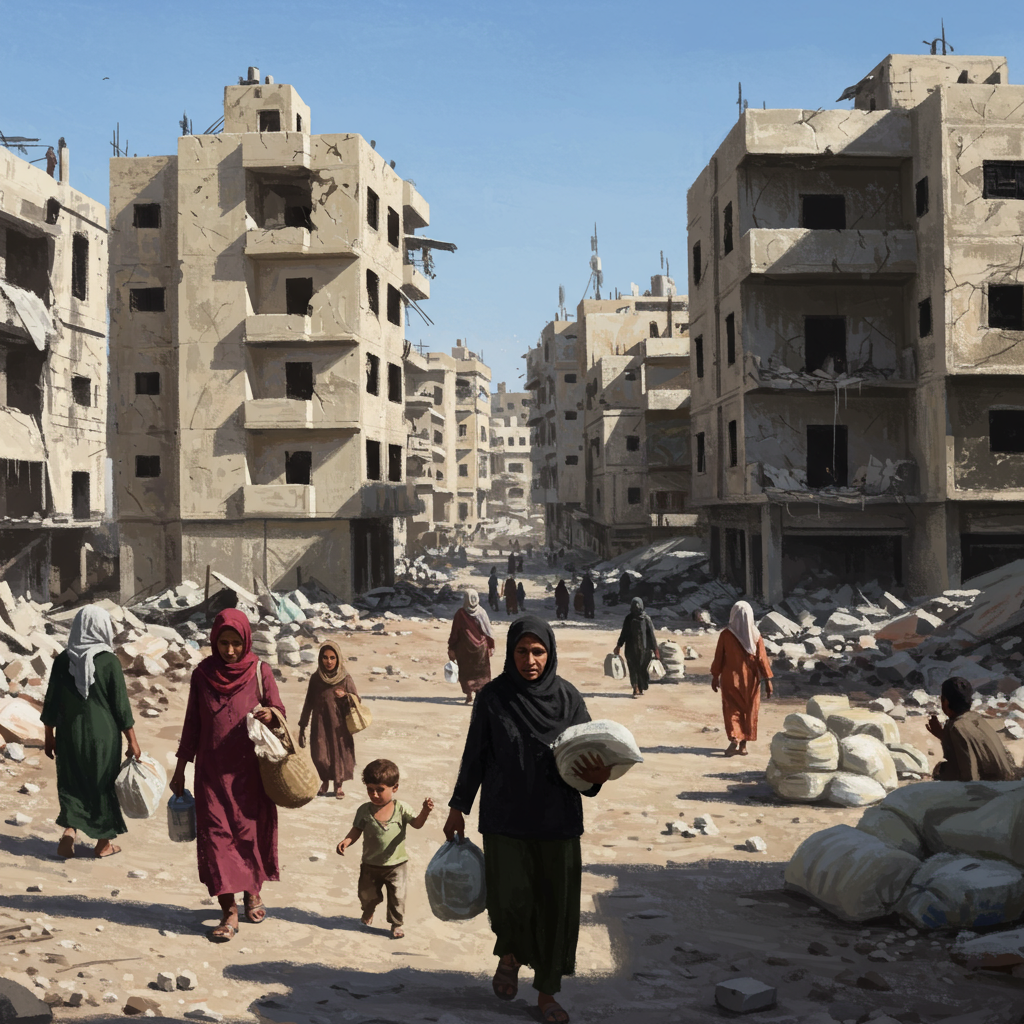The humanitarian crisis in Gaza has reached a devastating new peak, marked by escalating Israeli military operations and an unprecedented declaration of famine in Gaza City. Recent Israeli strikes have reportedly killed dozens of Palestinians, including aid-seekers and displaced civilians, intensifying global calls for an immediate ceasefire. Simultaneously, diplomatic efforts to halt the 22-month conflict remain stalled, leaving the region in a precarious state as military preparations for a major offensive on Gaza City accelerate.
Gaza City Gripped by Famine: A Dire Humanitarian Escalation
Gaza City, the enclave’s largest urban center, is officially experiencing famine, a highly rare pronouncement made by the Integrated Food Security Phase Classification (IPC) on Friday, August 22, 2025. This marks the first such declaration in the Middle East and signifies a catastrophic level of hunger, with the IPC warning that the famine is likely to spread across Gaza if the fighting and aid restrictions persist. Experts suggest that nearly half a million people in Gaza, roughly one-fourth of the population, are grappling with “catastrophic hunger,” placing many at imminent risk of death. This dire situation has been exacerbated by extensive displacement and the collapse of local food production systems.
The IPC’s findings underscore months of warnings from aid organizations about starvation among civilians, directly linked to the ongoing conflict, which began after Hamas’s attacks on October 7, 2023, and Israel’s subsequent restrictions on food and medical supplies. While Israel permitted airdrops and increased land aid in recent weeks following global outrage, the United Nations and other agencies maintain that the quantity of food reaching Gaza remains critically “insufficient.”
Aid Challenges and Conflicting Narratives
Humanitarian aid delivery within Gaza is fraught with peril. A previous 2.5-month Israeli blockade earlier this year significantly worsened conditions. Although access later eased, focusing on a new U.S.-backed private supplier, the Gaza Humanitarian Foundation (GHF), the situation remains dire. Journalists have witnessed chaos and security challenges at aid delivery points, alongside reports of Israeli troops firing towards aid-seekers. The Israeli military asserts that warning shots are only fired when individuals pose a direct threat to soldiers. However, harrowing accounts from aid-seekers, such as Mohamed Saada near the Zikim crossing, describe “huge numbers of people,” widespread shootings, and trucks running over individuals, often leaving many empty-handed.
Israel, through Prime Minister Benjamin Netanyahu’s office, has vehemently rejected the IPC’s famine declaration as “an outright lie,” accusing Hamas of starving hostages and insisting that sufficient aid has entered Gaza throughout the war. This stark contrast in narratives highlights the deep divisions surrounding the crisis and the immense pressure on all parties.
Escalating Military Actions and Civilian Casualties
The period leading up to the famine declaration saw a significant increase in Israeli military activity and a tragic rise in Palestinian casualties. On Saturday, August 23, 2025, Israeli strikes and shootings around Gaza reportedly killed at least 33 Palestinians. These victims included individuals sheltering in tents and those desperately seeking food aid.
Specific incidents included strikes in the southern Gaza Strip, particularly Khan Younis, where at least 17 people were killed. Over half of these casualties were women and children, with strikes reportedly targeting tents housing displaced individuals. In northern Gaza, near the critical Zikim crossing—a key entry point for humanitarian convoys—Israeli gunfire killed at least five aid-seekers. Among them was cameraman Khaled al-Madhoun, who the Palestinian Journalists Syndicate claims was intentionally targeted by Israeli troops while covering the events. Additional fatalities occurred in other attacks across Gaza, according to health officials and the Palestinian Red Crescent. These incidents have fueled a pervasive sense of insecurity, with civilians like Awad Abu Agala lamenting that “no place in Gaza is now safe.”
Looming Offensive on Gaza City
Despite the escalating humanitarian catastrophe, the Israeli military is pressing ahead with preparations for a wide-scale offensive on Gaza City. Ground troops are already active on the city’s outskirts and within its Zeitoun neighborhood. Israel maintains that Gaza City remains a significant Hamas stronghold, featuring an extensive network of militant tunnels. This planned offensive, potentially just days away, raises serious concerns given that hundreds of thousands of civilians, many of whom are already displaced, reside in the area. Doctors Without Borders (MSF) reports a “marked increase in airstrikes since early August,” leading to a surge in patients at their Gaza City clinics and further displacement of residents, including MSF staff, as people flee bombardments.
Stalled Ceasefire Efforts and Hostage Dilemmas
Efforts toward a ceasefire that could avert the looming offensive and alleviate the humanitarian crisis remain stalled, with mediators awaiting Israel’s next moves. The potential assault on Gaza City casts a long shadow over the fate of the estimated 20 hostages believed to be alive since October 2023, with another 30 thought to have died in captivity. Many Israelis fear that a major ground invasion could jeopardize the return of these captives.
Prime Minister Netanyahu recently instructed officials to begin immediate negotiations to release hostages and end the war “on Israel’s terms.” However, it remains unclear if Israel will re-engage in long-running talks mediated by the United States, Egypt, and Qatar, especially after Hamas indicated its acceptance of a new proposal from Arab mediators earlier this week. Hamas has conditioned the release of captives on an end to the war and the establishment of a Palestinian state, rejecting disarmament without this concession. Former U.S. President Donald Trump, expressing frustration with Hamas’s stance, described it as “extortion” and surprisingly suggested that a swift, aggressive ground invasion might paradoxically make the remaining hostages “safer.”
Internal Israeli Dissent and the Human Toll
The ongoing conflict and the hostage situation have also fueled internal dissent within Israel. A significant nationwide strike and widespread protests occurred on Sunday, August 17, 2025, demanding immediate government action for hostage release and a ceasefire. Protesters, including hostage families and bereaved families, chanted slogans like “We don’t win a war over the bodies of hostages,” highlighting deep divisions within Israeli society. These demonstrations, some of the fiercest since the conflict began, put immense pressure on Prime Minister Netanyahu, who must balance calls for hostage release with potential mutiny from far-right cabinet members, such as National Security Minister Itamar Ben-Gvir, who staunchly oppose any deal that could leave Hamas in power.
The cumulative human toll of the conflict is staggering. Gaza’s Health Ministry reported on Saturday, August 23, 2025, that at least 62,622 people have been killed since the war began, a figure that includes missing individuals later confirmed deceased. The ministry also noted a rise in malnutrition-related deaths, reaching 281, with specific reports of seven children dying from such causes within a 24-hour period on August 17.
Frequently Asked Questions
What led to the famine declaration in Gaza City, and what are its implications?
The Integrated Food Security Phase Classification (IPC) officially declared famine in Gaza City on August 22, 2025, marking the first such pronouncement in the Middle East. This dire situation resulted from the ongoing 22-month conflict, severe Israeli restrictions on food and aid, widespread displacement, and the collapse of local food production. The declaration implies a catastrophic level of hunger affecting nearly a quarter of Gaza’s population, with an urgent risk of spreading further. It intensifies global pressure on Israel to halt its offensive and ease humanitarian access, though Israel disputes the declaration.
Where are the main humanitarian aid challenges occurring in Gaza, and what efforts are underway?
Humanitarian aid faces significant challenges across Gaza, particularly at entry points like the Zikim crossing in the north and along roads leading to distribution points. These areas often experience chaos and insecurity, with reports of Israeli troops firing towards aid-seekers. While Israel has allowed some airdrops and increased land aid, including through a new U.S.-backed private supplier (GHF), aid agencies like the UN maintain that current efforts are “insufficient.” A 2.5-month Israeli blockade earlier in 2025 severely compounded the crisis, and aid organizations continue to push for unfettered access for relief supplies.
What are the primary obstacles preventing a ceasefire, and what are the stakes for involved parties?
Ceasefire efforts are currently stalled due to fundamental disagreements between Israel and Hamas. Hamas demands an end to the war and the establishment of a Palestinian state, rejecting disarmament without it, while Israel seeks an end to the war “on its terms.” The fate of approximately 20 remaining hostages is a critical point of contention, with Israeli protests calling for their release and fears that a major offensive on Gaza City could endanger them. Far-right elements within Israel’s government also oppose deals that would allow Hamas to retain power, further complicating negotiations mediated by the U.S., Egypt, and Qatar.
The crisis in Gaza represents an urgent confluence of military escalation, diplomatic stagnation, and a deepening humanitarian catastrophe. With an official famine declaration, rising civilian casualties, and a major offensive looming, the pressures on all parties, both international and domestic, have reached an unprecedented intensity, leaving the future of the region profoundly uncertain.




